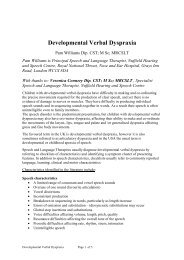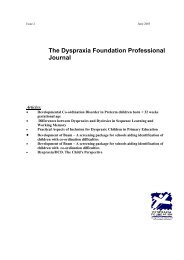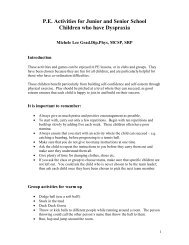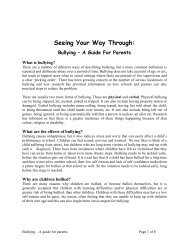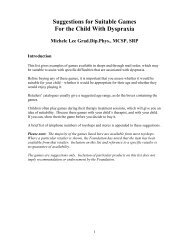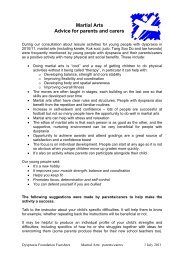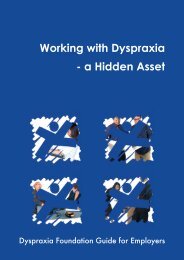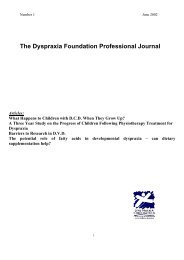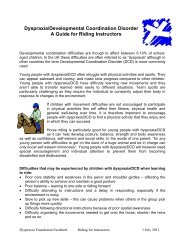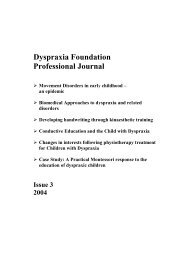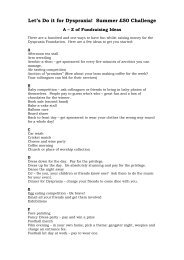Handwriting and Dyspraxia - Dyspraxia Foundation
Handwriting and Dyspraxia - Dyspraxia Foundation
Handwriting and Dyspraxia - Dyspraxia Foundation
You also want an ePaper? Increase the reach of your titles
YUMPU automatically turns print PDFs into web optimized ePapers that Google loves.
• Develop a sense of directional orientation using games such as ‘Bop it Extreme II’<br />
available from most Argos Stores<br />
Spatial Organisation<br />
The majority of children with dyspraxia will struggle to judge distances <strong>and</strong> assess space, this will<br />
not only effect gross motor skills but will also have a bearing on h<strong>and</strong>writing. Spaces between<br />
words may be omitted or placed erratically. This results in text becoming increasingly illegible. It<br />
is therefore crucial to teach the child how to provide adequate spaces between words <strong>and</strong> to space<br />
letters appropriately. To do this:<br />
• Use the ‘Write From the Start Perceptuo-Motor <strong>H<strong>and</strong>writing</strong> Programme’ especially<br />
section 2B.<br />
• Practice writing on grid paper placing each letter in a square <strong>and</strong> a space between each<br />
word.<br />
• Introduced joined writing very early in the child’s education, this is guaranteed to improve<br />
spatial organisation<br />
• Place a finger tip after each word before writing the next word.<br />
• Play games which involve judging distances i.e. obstacle courses<br />
• Use board games which involve spatial organisation such as connect 4, peg board patterns<br />
etc<br />
• Play ‘How many steps?’ st<strong>and</strong>ing with the child, ask ‘how many steps will it take you to<br />
reach that chair? The child then guesses. They are then encouraged to take those steps <strong>and</strong><br />
monitor their own movement. Initially the child may grossly under or overestimate the<br />
distance, but with time the estimations gradually become more accurate.<br />
Writing Flow<br />
Children who do not have adequate feedback as to their body position will lack a sense of rhythm.<br />
This will be apparent in their walking which may be heavy <strong>and</strong> awkward. Poor rhythm will also<br />
have a bearing on h<strong>and</strong>writing <strong>and</strong> children with dyspraxia may be so intent on foming the letters<br />
correctly that writing lacks flow, becomes very laboured <strong>and</strong> is increasingly slow resulting in<br />
limited output. This becomes an increasing concern when the child progresses through Key Stage 2<br />
<strong>and</strong> onto Key Stage 3 where there is an increased expectation in the volume of written work <strong>and</strong><br />
speed of output.<br />
• Introduce a variety of letter patterns i.e. ccccccccccc <strong>and</strong> attempt these to<br />
music, alternately follow a programme such as Callirobics<br />
• Introduce programmes such as ‘Joining the ABC’ by Charles Cripps, ‘Movement into<br />
<strong>H<strong>and</strong>writing</strong>’ By Prue wallis Myers or ‘Structured Cursive Writing’ by Chasty <strong>and</strong> Phillips.<br />
• Enjoy the activities in the ‘Write Dance’ programme by Ragnhild Oussoren Voors<br />
• The Speed_up!’ kinaesthetic h<strong>and</strong>writing programme is specifically designed to increase<br />
fluency <strong>and</strong> speed up h<strong>and</strong>writing for children aged 8 years <strong>and</strong> above.<br />
Augmentative technology<br />
As the expected volume of h<strong>and</strong>writing increases each school year so too will the child’s level of<br />
anxiety. It is at this time when a computer may be considered. This may be around the age of 8 or<br />
9 years. At this point word-processing can be introduced in parallel with h<strong>and</strong>writing. The child<br />
may eventually become more proficient at using a computer over h<strong>and</strong> skills or vice versa. It is<br />
important that the computer or keyboard is carefully selected <strong>and</strong> that the right scheme is<br />
introduced to help the child develop new skills. It is not important that touch typing is achieved<br />
with all fingers but that the child’s abilities are utilised fully to appreciate the technology available<br />
to him/her. The following contacts <strong>and</strong> references will help with this process.<br />
<strong>H<strong>and</strong>writing</strong> <strong>and</strong> dyspraxia Page 4 of 4



